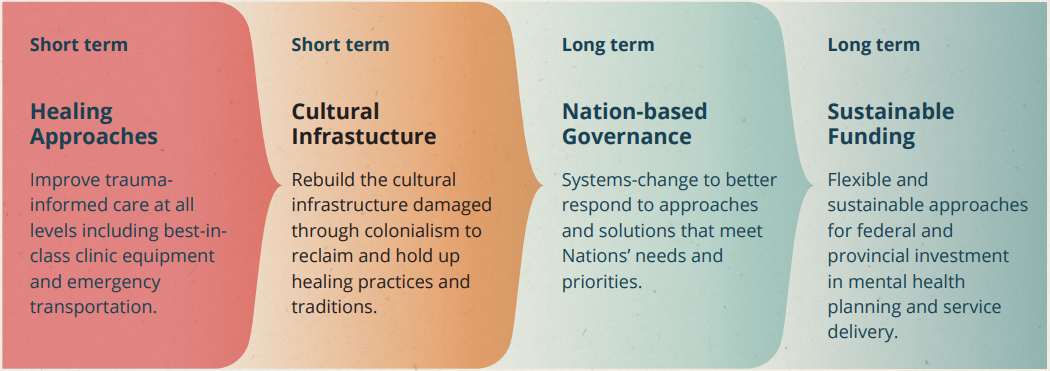Background
Transitioning from MOU to the 10 Year Strategy on the Social Determinants of Health
In 2018, the Memorandum of Understanding: Tripartite Partnership to Improve Mental Health and Wellness Services and Achieve Progress on the Determinants of Health and Wellness (“MOU") was signed by the First Nations Health Council (FNHC), the governments of British Columbia and Canada, along with the First Nations Health Authority (FNHA) as a supporter.
The MOU was intended to transform mental health and wellness services and improve mental health and wellness outcomes through the development and implementation of community-driven and Nation-based approaches that address the social determinants of health (SDOH). In December of 2022, an implementation evaluation was published which highlighted successes, challenges and next steps to further support communities and Nations.
The next phase of this work is being guided by the 10-Year Strategy on the Social Determinants of Health: A Framework for the Future (the Strategy), which was approved at Gathering Wisdom XII by Chiefs and leaders. The Strategy identifies four key areas of focus to address the social determinants of health and strengthen the health and wellness of First Nations individuals, families and communities:

About this Funding
The Social Determinants of Health Funding (SDOHF) is meant to provide Nations with flexible, sustainable, long-term funding to address the Social Determinants of Health (SDOH) in a way that works for them. This way, First Nations leaders can direct funding to projects and services that will have the greatest impact and address the unique needs of their people. Funding has been provided by the First Nations Health Authority, the Government of Canada and the Government of British Columbia.
Funding Approach
There is considerable diversity among First Nations in BC, with each Nation having their own stories, teachings and traditions related to well-being. Nations are also located in urban, rural and remote areas across the province, and have varying access to existing services and infrastructure. This funding is meant to be flexible, sustainable and long-term so that Nations can work towards their own unique priorities with more predictability and stability.
Through this approach, the Strategy also seeks to support Nation rebuilding through facilitating community cooperation and the pooling of resources to enhance the impact of funding. Funding amounts include a flat base allocation, along with consideration for rural and remoteness, with the balance of the amount based on total population (including members in community and those living away from home).
What are the Social Determinants of Health?
First Nations people have always recognized the complex factors that impact an individual's wellness such as mental, emotional, spiritual and physical elements. Broader factors like land, culture, community, family and Nations are also understood to be part of a fulsome understanding of wellness. The First Nations Perspective on Health and Wellness visually depicts this wholistic understanding of health and wellness, and describes the FNHA's Vision: Healthy, Self-Determining and Vibrant BC First Nations Children, Families and Communities.
The First Nations Perspective on Wellness links strongly to the SDOH. The SDOH are the “conditions in which people are born, grow, work, live, and age, and the wider set of forces and systems shaping the conditions of daily life."[1] “In traditional teachings about wellness, health is said to come with balance among mental and emotional, physical, spiritual, social and environmental conditions. The ability to thrive comes from harmony among these quadrants."[2] By addressing the SDOH and utilizing the First Nations Perspective on Health and Wellness we better inform and influence system change and improvement in a good way.
The Strategy notes that “traditional Indigenous healing approaches rely on intentionally keeping the factors of the social determinants of health in balance." These factors include:
- Culture, language and ceremony
- Self-determination genetics
- Income and social status
- Early childhood development
- Personal health practices and coping skills
- Physical environment
- Education
- Employment and working conditions
- Gender
- Social support networks
- Social inclusion
- Access to health services

Roles and Responsibilities
The Strategy is a framework for action and was developed by the FNHC as part of its health governance and advocacy role, and included several stages of engagement and approval with First Nations. Regional Caucus sessions, sub-regional sessions, working groups, Nation Assemblies and Provincial webinars were all part of the engagement pathway. The FNHA is recognized as the lead implementation body, and will work with First Nations and communities to reshape services. This includes providing regional support to Nations for planning and implementing projects related to the SDOHF.
[1] World Health Organization, Social Determinants of Health. https://www.who.int/health-topics/social-determinants-of-health#tab=tab_1 Retrieved 4/24/2024
[2] https://gathering-wisdom.ca/wp-content/uploads/GWXII_10-year-strategy_FINAL-online.pdf

